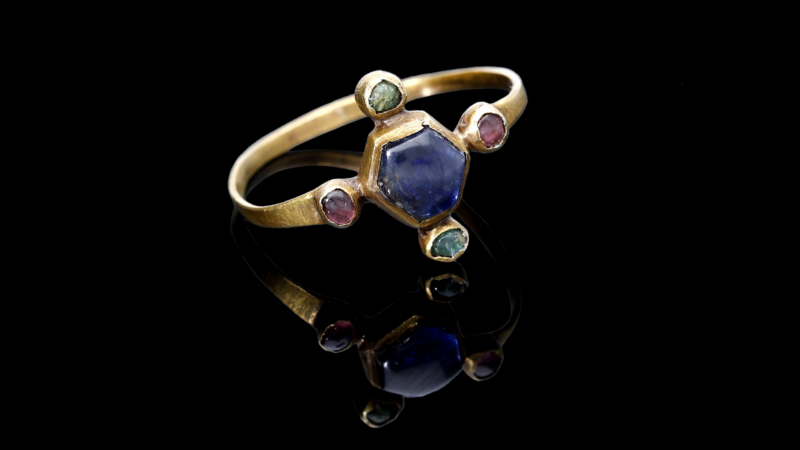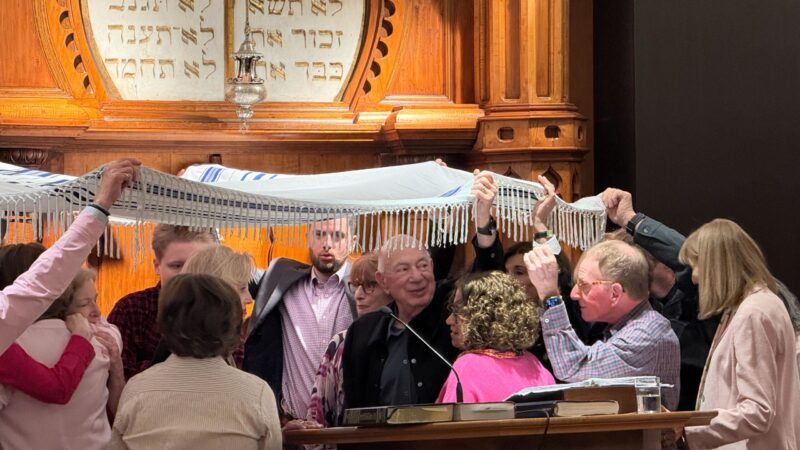A medieval Bishop’s ring from more than 800 years ago goes to auction
It sounds like a dream scenario for your average metal detectorist.
Picture yourself in a field, searching for hidden treasures, when suddenly you spot something shiny. Could it be gold?
For retired firefighter Mark Sell in Norfolk, England, the experience was even more remarkable. He discovered not just gold, but a Medieval Bishop’s ring dating back to the late 12th to early 13th century.
In November, 2019, Sell discovered the rare jewel in immaculate condition, with all its gemstones intact, in Shipdham, Norfolk. The ring was temporarily displayed at a museum dedicated to human history, culture and art. It is now scheduled to be auctioned at Noonans Mayfair, a London auction house, later this month.
Three things to know:
- Sell, 63, was out in a field using his metal detector with a friend when he got a faint signal and decided to dig. “I was amazed to see a thin line of gold in the clod of mud that I had dug up, and as I wiped away the mud, I could see the bezel of a medieval gold jeweled ring,” he told Noonan’s auction house.
- Laura Smith, a jewellery expert at Noonans auction house, explained that the style of jewel setting and its historical context suggest it likely belonged to a Bishop from the 12th or early 13th Century. The ring is set to be auctioned on March 26 and is estimated to fetch between $19,000 and and $23,000, according to the auction house. The profits will be split between Sell and the landowner of the field where the ring was discovered.
- After sharing his find with the landowner, Sell reported it to his local finds liaison officer, who is part of the U.K’s Portable Antiquities Scheme. This program, run by the British Museum, aims to record people’s everyday archeological discoveries into a historical database.
Listen to NPR’s State of the World podcast for a human perspective on global stories in just a few minutes, every weekday.
On display
While the ring was in the care of the British Museum, it was displayed temporarily for public viewing.
According to a Noonan representative, the Norwich Castle Museum has shown interest in acquiring the ring for permanent display. Originally a medieval royal fortification, the museum now serves as an art gallery and showcases significant objects from the region, including works of art, archaeological finds, and natural history specimens
The gold ring features a six-sided central hexagonal cabochon sapphire, complemented by two emeralds and two garnet stones, as described by Sell.
Dive deeper:
- Want more fuel to buy that metal detector? Here’s a story from last year on another fantastic historical find.
- Listen to NPR’s Short Wave podcast for more discoveries, everyday mysteries and the science behind the headlines.
Auburn fires coach Hugh Freeze following 12th loss in his last 15 SEC games
The 56-year-old Freeze failed to fix Auburn’s offensive issues in three years on the Plains, scoring 24 or fewer points in 17 of his 22 league games. He also ended up on the wrong end of too many close matchups, including twice this season thanks partly to questionable calls.
In a ‘disheartening’ era, the nation’s former top mining regulator speaks out
Joe Pizarchik, who led the federal Office of Surface Mining Reclamation and Enforcement from 2009 to 2017, says Alabama’s move in the wake of a fatal 2024 home explosion increases risks to residents living atop “gassy” coal mines.
‘It’s like feeling the arms of your creator just wrapped around you’: a visit to a special healing Shabbat
Members of Temple Emanu-El in Birmingham gathered recently for their traditional Friday Shabbat service. But this particular service was different, as could be seen by all the people dressed in their finest pink.
Space Command is coming to Huntsville. What might that mean for first-time homebuyers
While Huntsville has been a more affordable market than other growing cities, what’s it been like for those looking for their first home?
Colorado says relocation of Space Command to Alabama is ‘punishment’ for mail-in voting
The litigation announced by Colorado Attorney General Phil Weiser asks a federal judge to block the move as unconstitutional.
Breaking down Alabama’s CHOOSE Act
It’s been a year since Alabama legislators passed the CHOOSE Act allowing families to apply for state funds to use towards homeschool expenses and tuition for participating private schools. The Alabama Daily News’ education reporter Trisha Powell Crain has been diving into how the funds are being used. WBHM’s Andrew Gelderman sat down with her to talk about what we’re seeing so far.









